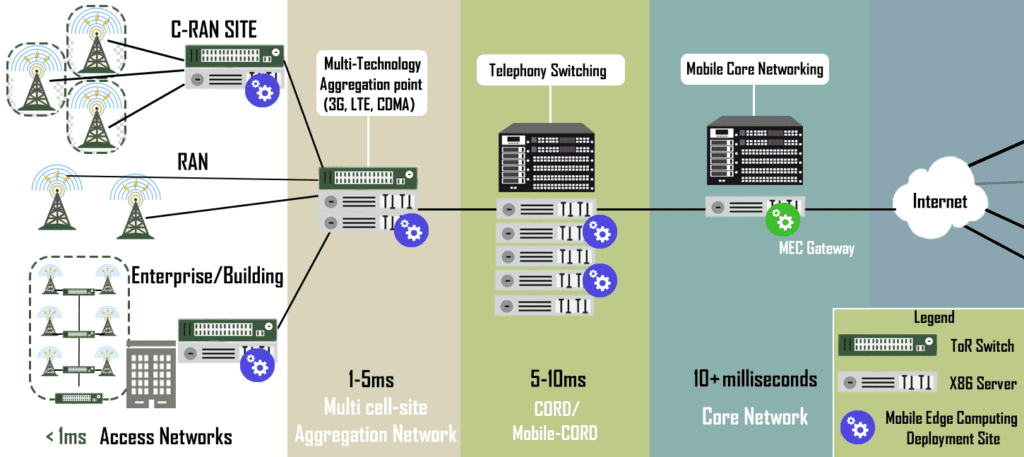That is because the small cell RAN (Radio Access Network) topology of 5G lends itself quite readily to the mobile edge computing model, as both solutions came about from the same root problems and they both ultimately aim towards reduced network latency, maximum scalability/elasticity and autonomy.
Requirements
The European Telecommunications Standards Institution set aggressive goals for 5g network specifications ( ~1ms latency, 1Gbps bandwidth per device/user, 1000x increase in concurrent device capacity). Due to a fundamental limitation (speed of light) this massively limits network deployment options and most importantly how far the resources (storage,compute) can be located.
Traditional, centralized network models (cloud computing/data centers, mobile core networking) cannot be be used if service providers and MNO’s wish to achieve the latency goals set for 5G due to the latency induced by the RTT (Round-trip-time) to the centralized resources and back.
The upgraded networks must bring not only the added improvements, but also maintain the same level of carrier-grade reliability.
The Solution Lanners NFV-ready Network Platform: HTCA-6200
Lanner’s HTCA-6200 is a NEBS-compliant network security platform featuring dual Intel Xeon®-grade CPU blades, dual network I/O blades with high-speed switching capacity and full redundancy system design To ensure the carrier-grade up-time and strict reliabilities mandated by telecom networks. HTCA-6200 is built with 2 CPU blades, each of them featuring dual Intel® Xeon® processor E5-2690 v3/v4 CPUs (24 cores per blade, a total of 48 cores across 2 blades) and 16x DDR4 R-DIMMs, optimized for high-performance in NFV applications.
To efficiently control and allocate packet load-balance, the dual, swappable network I/O blades can be configured with 1/10/40/100 GbE network ports in an array of QSFP, SFP+ or copper combinations. Each network I/O blade can support either BCM StrataXGS™ Trident-II BCM56854 Switch Fabric with a maximum of 720Gbps throughput or the Trident-II+ BCM 56860 with up to 1,280Gbps throughput. HTCA-6200 also comes with full redundancy design for its switch blades, CPU blades, cooling fans and power systems, which offer backup operation in case downtime occurs to one of these components.
Lanner’s HTCA-6200 platform has everything mobile network operators need to deploy a cost-effective mobile edge computing solution, combining both a high-capacity switch fabric and powerful Intel x86 server-class processors. Tested extensively with prominent NFVi platforms, this carrier-grade hardware is ready to accelerate new service deployment and develop exciting new revenue streams for service providers.
Deployment Options
The cost of this distributed deployment is significantly higher than the previous generations and there is no single network operator within the U.S is ready to take on such a massive deployment just yet. Optimizing LTE networks, reducing network latency and implementing 5G RAN technologies (millimeter-wave small cells) in population-dense areas is fast-becoming the preferred route for initial 5g deployments and goals.
The mobile networks within the United States must cover an extensive area and the cost-effectiveness in deploying the next-generation mobile networks will be a deciding factor. For that reason, several locations for deploying MEC appliances are available, each with their own Pros/Cons.
The Cellular Base Station/Access Networks:
Mobile Network operators can deploy MEC right in the Cellular base stations, the closest location next to the device. This introduces the possibility for sub-millisecond latency communications, but is not as cost-effective as other deployment options – as the deployment is tied to connections from that particular base station only.
Cellular technology Aggregation Site:
This is the part of the network in charge of combining all of the different cellular technologies into a single unified stream that is much more easily managed by the MNO’s (Mobile Network Operators).This is an optimal deployment option, striking a good balance between cost and speed. Here mobile edge computing can be implemented for numerous cell sites and service a much larger portion of the mobile network.
Carrier IP Aggregation:
A cost-effective location for implementing mobile edge computing, as more centralized datacenter-like scaling comes into play. The major downside to this deployment scenario is the latency induced from the longer distances and multiple hops transmissions have to make.
